Take the many rivers and mountains of Japan, a large pool of available labour, and a government with a rural power base and a tendency to sponsor megaprojects, and you get expressways to nowhere and dams and reservoirs everywhere. Yesterday I wrote about a super-intense fisherman I saw in one section of the Masubuchi Reservoir. Today I’ll write some more about the reservoir and its associated dams.
If you’ve been reading this series of posts for the last week or so, you’ll know that I just won’t shut up about a bicycle trip I took on April 30th. If this is your first visit, these links might be useful: Introduction, Part 1: Snakes, Part 2: Not A Temple, Part 3: Frogs, Part 4: Farming Grannies, and Part 5: Reservoir Mobs.
I followed the valley where I’d seen the farm ladies and the shrine with the frogs. At one point the valley split into two smaller ones, each home to a different stream with waterfalls near their respective sources. One of the waterfalls is called Sugao Falls, which I’ve been to a few times before. This time, in the spirit of exploration, I decided to take the other route, to the Masubuchi Dam, it’s associated reservoir, and the Nanae Falls (Seven Stage Falls) of one of its tributaries.
Being in the mountains, the road was uphill. But like most of the mountain roads I’ve been on here, they aren’t terribly steep. I think part of the reason for this is deference to the wimpier of the two types of personal vehicles here. Cars are classified by engine size. The ones with white license plates have larger, more powerful engines, and are more expensive to license. Yellow-plate cars have smaller engines, are cheaper to buy and license, and aren’t allowed on the major expressways. Licence plate colour doesn’t necessarily correspond to vehicle size, though, as some small cars with powerful engines are dwarfed by slow-moving delivery vans.
Steep roads would be impassable for the yellow plate cars, so the roads usually follow long gentle slopes. From my cyclist’s perspective this is a good thing, except that I’ve frequently had five- to eight-kilometre stretches of 10% climbs interspersed with shorter, steeper sections. Some days I’d rather just have a short, impossibly steep climb that I can walk my bike up.
The region is promoted as a cycling area—there’s even a place to rent bikes—so most of the slopes are even gentler than usual. This is a good thing, since most of the rental bikes are mama-charis—what we call granny bikes back home—thin, medium-pressure tires, one speed, a heavy steel frame, and big basket in front. Except that in Japan, it’s not just the grannies that ride them. Everyone does. Students, housewives, businessmen, old men and women, children. Everyone.
Here’s a picture of my lovely wife a beautiful young foreigner posing with her mama-chari. The bicycle is generic, made of steel tubing. One speed, with rattling brake levers and a seized up rear hub. Bottle-dynamo headlamp and chronically underinflated tires. Our model’s wardrobe? Jeans by Uniqlo, small backpack by Boblbee, footwear by Naot, and zippered shirt by Gouk. Shot on location near the main torii of Sugawara Shrine, under the wisteria of a private garden.
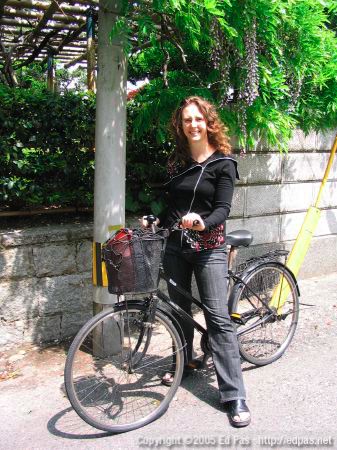
But I digress. Here’s the view from the top of the dam:
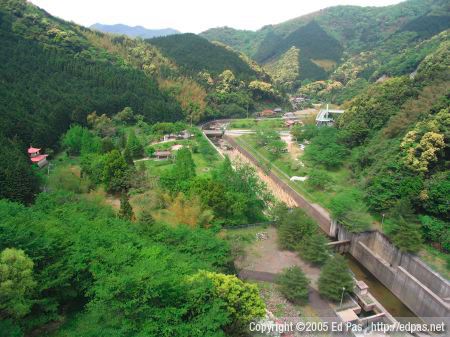
To give a sense of scale, here’s a close-up view of a farmhouse that can be seen from the top of the dam. I took this photo on my way towards the top. The farmhouse is in the cluster of buildings at the farthest bend in the road of the photo above.
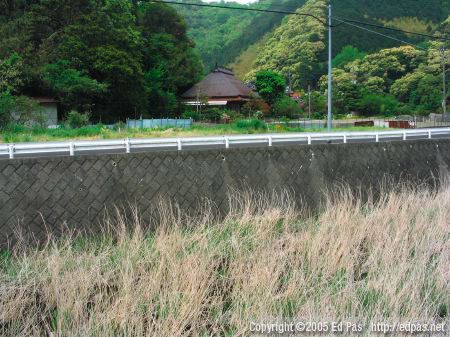
There’s a lovely paved trail all around the reservoir. It’s closed to motorized vehicles, with barriers and large signs announcing that only cyclists and pedestrians are allowed. Cyclists can’t go terribly fast due to a lot of twists in the wide, smooth road—I’d guess that 20-25kph is the upper limit for safe riding—though I think I exceeded that on multiple occasions.
And across the reservoir is a beautiful red suspension bridge. It seems that no reservoir is complete without a red bridge of some sort. In fact, red seems to be the colour of choice for bridges in this country. I can think of at least four in Kitakyushu, and a couple elsewhere.
Here’s a view of the suspension bridge over the Masubuchi reservoir:

Here’s another picture of the suspension bridge, with a person on it to give a sense of scale:

And another of the bridge, looking across from the entrance:
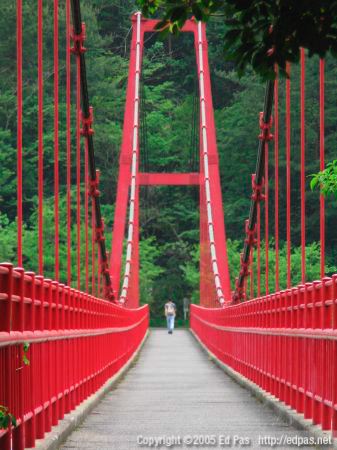
I have three photos showing view of the reservoir from the second dam. Without the three photos it’s a bit difficult to imagine the scale of the place. I’m going to apologize in advance for their quality—it was a hazy day and I took them more for documentation than as an attempt to take good photos—so consider yourselves warned. The view is in the general direction of the first dam, which can’t be seen because of the crinkly shoreline. It’s approximately in the direction of the small mountain behind everything else, left of centre of the first picture below.
First, a general view, showing as much as my camera can see with it’s wide-angle converter:
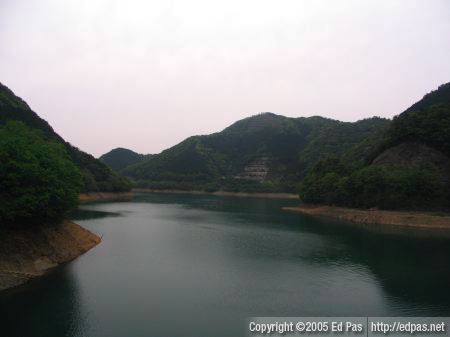
A zoomed in view, using a tele-converter. You can see the stepped rock face that’s in the center of the first photo. Note the dark blob along the shoreline, about two-thirds of the way from the left side.

And finally, a super-zoomed in view using my spycam. This is the dark blob from the second photo. It s a fisherman and a dog.
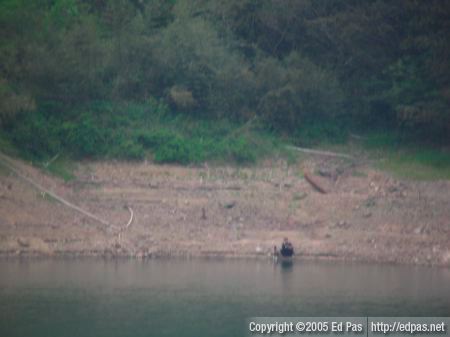
As you can see from the exposed shoreline, the reservoir isn’t full. Rainy season will be upon us starting in the next couple of weeks so the water level is sure to rise. I’ve read somewhere that this reservoir supplies about ten percent of Kitakyushu’s water.
I really loved this area. It was quiet due to its remoteness. There was a really good cycling road, with few other people to dodge. And there was some really good hiking, and a beautiful waterfall nearby, which I’ll write about soon.
And finally, happy Mother’s Day to all the moms out there.
[The next post in this series is Rural Kitakyushu: Sevenfold Waterfalls Part 1]
I imagine your long cycling explorations are akin to papa’s long rides on his motorbike in 1960’s Taiwan. Very cool. As I recall, he too loved to take photographs, black and white ones on his Leica. When I was in Taiwan ten (!) years ago there was a reservoir that I particularly enjoyed visiting, but no red bridge. It had a very picturesque pagoda though. (And I’m guessing you have no idea that you might be asking for trouble mentioning wisteria and your lovely wife in the same paragraph?)
Yeah, I’ve thought about that a lot lately. Plus his love of visiting temples, shrines, festivals and suchlike. Regarding the wisteria, it’s true: I have no idea what you’re getting at. Care to enlighten me?
Just an oblique reference to a rather popular TV show called Desperate Housewives, which takes place on Wisteria Lane in suburbia, USA. It’s a pretty funny show, with the women doing all KINDS of crazy things. Not that you watch that sort of thing even when in this neck of the woods! But given the earthquakes and other neurosis-inducing aspects of Kitakyushu, you never know what might happen! 😉